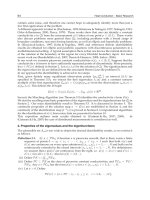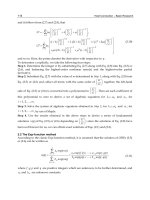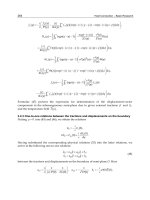Convection and Conduction Heat Transfer Part 12 potx
Bạn đang xem bản rút gọn của tài liệu. Xem và tải ngay bản đầy đủ của tài liệu tại đây (3.83 MB, 30 trang )
6 Will-be-set-by-IN-TECH
different elements are assembled together by requiring the balance of this flux from each
element to its neighbours and the continuity of the temperature field T
(r, t ).Thissystem
of equations is commonly written in matrix form as:
M
e
˙
T
e
+
ˆ
K
e
T = F
e
,(9)
where
M
e
= M
e
ij
ˆ
K
e
= K
e
ij
− I
ij
Γ
2
ψ
i
−h − σ
s
T
3
dS
F
e
= Q
e
i
+
Γ
2
ψ
i
q
laser
+ hT
∞
+ σ
s
T
4
∞
dS,
(10)
with I
ij
the identity matrix.
The equations of the single elements are assembled by summing the element equations
corresponding to the same nodes:
M
=
∑
e
M
e
,
ˆ
K =
∑
e
ˆ
K
e
, F =
∑
e
F
e
, (11)
resulting in the global equation:
M
˙
T
+
ˆ
KT
= F. (12)
The system of ordinary differential equations expressed by the matrix equation 12 must be
completed by providing an initial condition T
(0)=T
0
. Therefore we seek to solve the initial
value problem defined by:
M
˙
T
+
ˆ
KT
= F,
T
(0)=T
0
.
(13)
This can be converted to a system of algebraic equations by dividing the time domain into
steps and using finite differences to approximate the time derivatives. Equation 13 can be
solved by considering a weighted average of the time derivatives at two consecutive time
steps (t
s
and t
s+1
) and developing an iterative procedure to find the solution at each step
(Reddy & Gartling, 1994):
T
(t
s+1
)=T(t
s
)+
˙
T
(t
s+α
)(t
s+1
− t
s
),
˙
T
(t
s+α
)=(1 − α)
˙
T
(t
s
)+α
˙
T(t
s+1
).
(14)
Different choices of α lead to well known approximation schemes that are commonly found
in the literature:
α
= 0, forward difference, or Euler, scheme
α
= 1/2, Crank-Nicholson scheme
α
= 2/3, Galerkin scheme
α
= 1, backward difference scheme.
320
Convection and Conduction Heat Transfer
Modelling of Heat Transfer and Phase Transformations in the Rapid Manufacturing of Titanium Components 7
Substitution of Equation 13 in Equation 14 yields the solution to the problem:
T
(t
s+1
)=T(t
s
)+(1 − α)M
−1
[
T(t
s
)
]
F
[
T(t
s
)
]
−
ˆ
K
[
T(t
s
)
]
T(t
s
)
(t
s−1
− t
s
)
αM
−1
[
T(t
s+1
)
]
F
[
T(t
s+1
)
]
−
ˆ
K
[
T(t
s+1
)
]
T(t
s+1
)
(t
s−1
− t
s
).
(15)
In general Equation 15 leads to an implicit scheme that requires iterative solutions to be found
within each time step. The forward difference method is the only one of the above which is an
explicit method and is the easiest to implement. It results in a simple iterative solution where
T
(t
s+1
) is readily obtained from the solution at the previous step T(t
s
), and is given by:
T
(t
s+1
)=T(t
s
)+M
−1
[
T(t
s
)
]
F
[
T(t
s
)
]
−
ˆ
K
[
T(t
s
)
]
T(t
s
)
(t
s−1
− t
s
). (16)
Starting from T
(0)=T
0
, the solution at subsequent steps can be calculated from Equation
16. Equation 16 is a general expression that relates the temperatures at various points of a
geometry by requiring the balance of heat fluxes across the boundaries between neighbouring
elements and the continuity of the temperature field, governed by the weak form of the
heat conduction equation. The temperature evolution during additive manufacture for a
component of arbitrary geometry can be found by implementing Equation 16 as a computer
code.
2.3 Representation of the physical domain
A finite element model should ideally describe the geometry of the substrate and the tracks
as closely as possible. Frequently the substrate is a parallelepiped which can be easily
represented in the form of a finite element mesh. However, it is more difficult to develop
a mesh which allows a step wise description of the deposition of tracks with complex 3-D
features, such as curved cross sections or curved fronts. To describe the full detail of track
overlap during manufacture, the finite element mesh becomes complex and requires many
elements for the proper representation of the 3-D features of the tracks, as shown in Figure
2.a.
1
2
3
(a) (b)
Fig. 2. (a) Finite element mesh of substrate and tracks. (b) Step-wise approach to simulate the
addition of material. New elements are activated at liquidus temperature. Adapted from
Crespo and Vilar (Crespo & Vilar, 2010)
One commonly applied strategy to reduce the number of elements is to use a fine mesh only
in regions which have complex geometries or where thermal gradients are expected to be high
(in the vicinity of interaction zone between the energy source and the material), while using
a coarser mesh away from these zones (Figure 2.a). The level of refinement shown in Figure
321
Modelling of Heat Transfer
and Phase Transformations in the Rapid Manufacturing of Titanium Components
8 Will-be-set-by-IN-TECH
2.a is necessary if certain aspects of the fabrication process such as the formation of hot-spots
or the solidification rate must be predicted, which require the precise shape of the melt pool
and of the incorporated material to be taken into account (Bontha et al., 2006; Crespo et al.,
2006). When the purpose of the simulation does not demand such a rigorous description
of the track shape, simpler meshes may be used by assuming that the shapes of the melt
pool and of the tracks can be approximated by simpler geometries. This has the advantage
of reducing considerably the number of elements in the mesh, and as a consequence the
number of calculations and the computational time necessary to resolve the problem. Several
authors have developed finite element models which use simple cubic elements to simulate
the addition of material and have demonstrated the validity of this approach (Costa et al.,
2005; Deus & Mazumder, 2006), which is also used in the present work. If the deposition if
assumed to take place in the mid-plane of the substrate, there is a symmetry plane in respect of
which heat flow is symmetrical and one needs only consider half the geometry of the problem,
as illustrated in Figure 2.b, further reducing the computational time needed to achieve the
solution for the heat transfer problem.
In the model proposed in this chapter, Equation 16 is solved iteratively for each element in
the step by step approach described in the previous section. Addition of material is taken
into account by activating at each new time step elements with a volume corresponding to
the volume of material incorporated into the part during the duration of that step (Figure
2.b), based on a methodology first presented by Costa et al. (Costa et al., 2005). Taking into
consideration the results of Neto and Vilar (Neto & Vilar, 2002), who showed that in blown
powder laser cladding the powder flying through the laser beam often reaches the liquidus
temperature before impinging into the part, the newly active elements are assumed to be at
the liquidus temperature.
3. Phase transformations during the rapid manufacturing of titanium components
Titanium alloys are being increasingly used in a wide range of applications due to properties
such as high strength to weight ratio, excellent corrosion resistance, high temperature strength
and biocompatibility. These properties have made titanium alloys a widespread material
in industries such as the aerospace, automotive, biomedical, energy production, chemical,
off-shore and marine industries, among others (Boyer et al., 1994; Donachie, 2004).
In the last decade, the Ti-6Al-4V alloy has accounted for more than half the production of
titanium alloys worldwide, a market estimated at more than $2,000 million (Leyens & Peters,
2003). This predominance is mainly due to Ti-6Al-4V having the best all-around mechanical
characteristics for numerous applications. This alloy is extensively used in the aerospace
industry for the production of turbine engines and airframe components, which account
for approximately 80% of its total usage. Additionally, Ti-6Al-4V presents excellent
biocompatibility and osseointegration properties which have made it a natural choice as
a biomaterial for the fabrication of implants and other biomedical devices (Brunette, 2001;
Yoshiki, 2007). When compared to other materials usually used for the same purpose, such as
stainless steel or CoCr alloys, Ti-6Al-4V allows the production of much stronger, lighter and
less stiff implants and with improved biomechanical behaviour.
Ti-6Al-4V is an α/β titanium alloy that contains 6% of the α-phase stabilising element Al,
and 4% of the β-phase stabilising element V in its composition. As a result of the combined
effect of these two alloying elements, the equilibrium microstructure of Ti-6Al-4V consists of
322
Convection and Conduction Heat Transfer
Modelling of Heat Transfer and Phase Transformations in the Rapid Manufacturing of Titanium Components 9
Fig. 3. Phase transformations during rapid manufacturing of Ti-6Al-4V.
amixtureofα and β phases for temperatures between room temperature and 980
◦
C, which
is called the β-transus temperature (Polmear, 1989). The proportion of β phase in equilibrium
depends on the temperature, varying from approximately 0.08 at room temperature to 1.00 at
the β-transus, and is given by (R. Castro, 1966):
f
eq
α
(T)=
0.925
− 0.925.e
[0.0085(980−T)]
, T ≤ 980
◦
C/s
0, T
> 980
◦
C/s
f
eq
β
(T)=1 − f
eq
α
(T),
(17)
with T in
◦
C. In titanium alloys the β-transus temperature represents the minimum
temperature above which β is the only equilibrium phase. The phase transformations that
can occur due to the consecutive thermal cycles generated by layer overlap during build-up
of parts by rapid manufacturing are represented in the diagram of Figure 3.
3.1 Phase transformations during cooling from the liquid phase
Prior to incorporation into the part the feedstock Ti-6Al-4V is melted, and after solidification
its structure consists of β phase. During cooling to room temperature β may undergo two
different phase transformations depending on the cooling rate.
323
Modelling of Heat Transfer
and Phase Transformations in the Rapid Manufacturing of Titanium Components
10 Will-be-set-by-IN-TECH
3.1.1 Diffusional transformations
For cooling rates lower than 410
◦
C/s, a β → α transformation takes place controlled by a
diffusional mechanism, starting at the β-transus temperature (980
◦
C). At room temperature,
the final microstructure consists of α and β because the transformation does not reach
completion. In isothermal condition the kinetics of this transformation is described by the
Johnson-Mehl-Avrami (JMA) equation:
f
(t)=1 − ex p
(
−
jt
n
)
, (18)
where f
α
(t), k and n are the fraction of α formed after time t, the reaction rate constant
and the Avrami exponent, respectively. The values for k and n were determined as a
function of the temperature by Malinov et al. (Malinov, Markovsky, Sha & Guo, 2001). The
Johnson-Mehl-Avrami equation cannot be used to describe the kinetics of anisothermal
transformations because the reaction rate constant k depends on the temperature. As a
consequence, the direct integration of the Johnson-Mehl-Avrami equation to calculate the
transformed proportion during cooling is not possible. Nevertheless, good results have
been achieved by generalising the Johnson-Mehl-Avrami equation to anisothermal conditions
using the additivity rule (Malinov, Guo, Sha & Wilson, 2001; S. Denis, 1992). In this method,
continuous cooling is replaced by a series of small consecutive isothermal steps where the
Johnson-Mehl-Avrami equation can be applied. During the first isothermal time step,
[t
0
, t
1
[,
at temperature T
0
, the fraction of α phase formed can be calculated from Equation 18 and is
given by:
f
α
(t
1
)=
1
− ex p
[
−
k
0
(t
1
− t
0
)
n
0
]
. f
eq
α
(T
0
) (19)
where k
0
and n
0
are the reaction rate constant and Avrami exponent at the temperature T
0
,
respectively. In the next interval,
[t
1
, t
2
[, the transformation is assumed to take place at the
temperature T
1
, but one must take into consideration the fact that a fraction f
α
(t
1
) of α phase
has already formed in the previous step. Substituting the fraction f
α
(t
1
) in Equation 18, one
can calculate the time it would take to form the proportion f
α
(t
1
) of α phase if the whole
transformation had taken place at the temperature T
1
:
t
f
1
=
n
1
−
ln[1 − f
α
(t
1
)/ f
eq
α
(T
1
)]
k
1
, (20)
where k
1
and n
1
are the reaction rate constant and Avrami exponent at the temperature T
1
.
The additivity principle requires that t
f
1
be the initial time for the new transformation step.
Therefore, for the time interval
[t
1
, t
2
[,onegets:
f
α
(t
2
)=
1
− ex p
−k
1
(t
f
1
+ t
2
− t
1
)
n
1
. f
eq
α
(T
1
). (21)
Equation 21 can be generalised for an arbitrary time step
[t
s
, t
s+1
[ at temperature T
s
,leading
to a fraction of α formed during that step given by:
f
α
(t
s+1
)=
1
− ex p
−k
s
(t
f
s
+ t
s+1
− t
s
)
n
s
. f
eq
α
(T
s
), (22)
324
Convection and Conduction Heat Transfer
Modelling of Heat Transfer and Phase Transformations in the Rapid Manufacturing of Titanium Components 11
where t
f
s
is given by:
t
f
s
=
n
s
−
ln[1 − f
α
(t
s
)/ f
eq
α
(T
s
)]
k
s
. (23)
The application of the additivity rule to the Johnson-Mehl-Avrami equation is illustrated in
Figure 4.
Fig. 4. Generalization of the Johnson-Mehl-Avrami equation for anisothermal
transformations.
3.1.2 Martensitic transformations
For cooling rates higher than 410
◦
C/s the β → α diffusional transformation is suppressed
and β decomposes by a martensitic transformation. The proportion of β transformed
into martensite (α
) depends essentially on the undercooling below the martensite start
temperature (M
s
) and is given by (Koistinen & Marburger, 1959):
f
α
(T)=1 − exp
[
−
γ(M
s
− T)
]
. (24)
325
Modelling of Heat Transfer
and Phase Transformations in the Rapid Manufacturing of Titanium Components
12 Will-be-set-by-IN-TECH
The values of γ, M
s
and M
f
used in the present work (0.015
◦
C
−1
, 650
◦
C and 400
◦
C
respectively) were calculated on the basis of the results of Elmer et al. (Elmer et al., 2004).
If the material cools below M
f
its microstructure is fully martensitic.
3.2 Phase transformations during re-heating
When new layers are added to the part, the previously deposited material undergoes
heating/cooling cycles that may induce microstructural and properties changes. If the
microstructure formed in first thermal cycle is composed of α
+ β, reheating will lead to
diffusion controlled α
→ β transformation with a kinetics described by the JMA equation
generalised to anisothermal processes (Equation 22). If, on the other hand, the microstructure
is martensitic, heating up the material into the tempering range (> 400
◦
C) will cause the
decomposition of α
into a mixture of α and β. This transformation is also diffusion controlled
and its kinetics are also described by the JMA equation (Equation 18). The values of k and
n in Equation 18 for this reaction were determined by Mur et al. (Mur et al., 1996). If the
decomposition is incomplete, tempering results in a three-phase microstructure consisting of
α
+ α + β.
3.3 Phase transformations during second cooling
During cooling down to room temperature at cooling rates lower than 410
◦
C/s β phase
decomposes into α by a diffusion controlled mechanism. For cooling rates in excess of
410
◦
C/s β may undergo a martensitic transformation or be retained at room temperature,
depending on the volume fraction of this phase in the alloy. Several authors have observed
that β is completely retained upon quenching if its proportion in the alloy is lower than
0.25, because the β phase is enriched in vanadium, a β stabiliser (Fan, 1993; Lee et al., 1991;
R. Castro, 1966). If the volume fraction is higher than 0.25 a proportion of β given by (Fan,
1993):
f
r
= 0.25 − 0.25. f
β
(T
0
), (25)
is retained at room temperature, where f
b
(T
0
) isthevolumefractionofβ prior to quenching.
The remaining β ( f
b
(T
0
) − f
r
) undergoes a martensitic transformation. As a result, cooling
an alloy consisting only of β phase at rates higher than 410
◦
C/s originates a fully martensitic
structure, while materials with smaller volume fractions of this phase retain a variable
proportion of β (Figure 3). Thus, the martensite volume fraction is given by:
f
α
(T)= f
α
(T
0
)+(f
β
(T
0
) − f
r
)
[
1 − exp
(
−
γ(M
s
− T)
)]
, (26)
with f
α
(T
0
) the volume fraction of α
phase present in the alloy prior to quenching.
Similar phase transformations will occur during subsequent thermal cycles and the final
microstructure will result from all the consecutive transformations occurring at each point.
3.4 Calculation of mec hanical properties
The Young’s modulus and hardness were calculated from the phase constitution of the alloy
using the rule of mixtures (Costa et al., 2005; Fan, 1993; Lee et al., 1991). The Young’s moduli
of α, β and α
are 117, 82 and 114 GPa respectively and the Vickers hardnesses are 320, 140 and
350 HV.
326
Convection and Conduction Heat Transfer
Modelling of Heat Transfer and Phase Transformations in the Rapid Manufacturing of Titanium Components 13
4. Results
4.1 Experimental confirmation
The model was first validated by comparing the calculation results with the experimental
distributions of microstructure and properties found in Ti-6Al-4V walls produced by laser
powder deposition (LPD), a rapid manufacturing technique that uses a focused laser beam
to melt a stream of metallic powder and deposit the molten material continuously at precise
locations (Laeng et al., 2000; R.Vilar, 1999; 2001).
4.1.1 Simulation results
The model was applied to simulate the phase transformations occurring during the deposition
of a 75 layer Ti-6Al-4V wall with 0.32 mm width, 10.00 mm length and 3.50 mm height,
represented in Figure 5. The scanning speed was 4 mm/s, the laser beam diameter 0.3
mm, the idle time between the deposition of consecutive layers 6 s and the initial substrate
temperature 20
◦
C. The laser beam power was varied according to the plot of Figure 6.a,
reflecting the power adjustments performed by a closed loop online control system utilised
during the manufacture of the experimental sample, which acts to keep the size of the melt
pool generated by the laser beam at the surface of the workpiece constant. An initial beam
power of 130 W was used and progressively decreased with each new deposited layer up to
the 20th layer, where a beam power of 50 W was reached and kept constant for the rest of the
process. An average absorptivity of 15 % was considered in the calculations, according to the
results of Hu et al. (Hu & Baker, 1999) regarding the laser deposition of Ti-6Al-4V using a CO
2
laser.
Fig. 5. View of the substrate and the wall with a detail of the wall mesh.
The calculated phase distribution is shown in Figures 6.b and 7. The highest volume fractions
of α and β phases (0.03 and 0.07 respectively) occur close to the substrate, and decrease as
the distance from the substrate increases, reaching zero in the uppermost layers of the part.
Conversely, the volume fraction of martensite is lowest near the substrate (approximately
0.9) and has a maximum at the top of the wall, where the structure is fully martensitic.
The cooling rates experienced by the material during the deposition process are always
higher than 410
◦
C/s (Figure 8.a), and, as a consequence, after solidification the material
undergoes a martensitic transformation during cooling to room temperature. Figure 8.a
327
Modelling of Heat Transfer
and Phase Transformations in the Rapid Manufacturing of Titanium Components
14 Will-be-set-by-IN-TECH
(a) (b)
Fig. 6. (a) Laser beam power used to deposit each layer. (b) Phase constitution as a function
of the distance from the fusion line.
Fig. 7. β phase distribution.
shows that the cooling rate progressively decreases as the number of layers increases and
asymptotically approaches a value below the martensite critical cooling rate (410
◦
C/s).
Therefore, the deposition of additional layers would likely lead to the suppression of the
martensitic transformation in the top layers of the part.
The thermal cycles originated by layer overlap heat up the previously deposited material to
temperatures in the tempering range (T
> 400
◦
C), causing the progressive decomposition of
the martensite into α and β (Figure 8.b).
The idle time between the deposition of consecutive layers used (6 s) is too short to allow the
part to cool down to room temperature before the deposition of a new layer. As a result the
temperature of the workpiece increases progressively as the deposition advances, eventually
stabilising at approximately 270
◦
C after the deposition of the 15
th
layer, as depicted in the
plot of Figure 9.a.
This facilitates tempering because, as heat accumulates in the part, the material residence
time in the tempering temperatures range increases from less than 1 s in the first cycles to
approximately 4 s from the 15
th
cycle onwards (Figure 9.b).
The cumulative effect of the consecutive thermal cycles is sufficient for significant tempering
to take place, particularly in the layers deposited at the beginning of the buildup process.
For example, the material in the first layer is subjected to 74 thermal cycles subsequent to
328
Convection and Conduction Heat Transfer
Modelling of Heat Transfer and Phase Transformations in the Rapid Manufacturing of Titanium Components 15
(a) (b)
Fig. 8. (a) Cooling rates experienced by the material deposited in the different layers. (b)
Temperature evolution of the material deposited in the first layer for the first 120 s of the
fabrication process. Tempering of the martensite takes place at temperatures higher than 400
◦
C.
(a) (b)
Fig. 9. (a) Temperature evolution of the interface between the wall and the substrate after the
deposition of each layer. (b) Time above 400
◦
C during the deposition of each layer,
measured at the interface between the wall and the substrate.
its deposition, which amounts to approximately 250 s in the tempering range, leading to a
decomposition of approximately 10% of the previously formed martensite. The evolution of
the phase constitution of the material is presented in Figure 9.a and the Young’s modulus and
hardness variations along the wall height are presented in Figure 10.b
4.1.2 Experimental results
The distributions of microstructure, Young’s modulus and hardness predicted by the model
were compared to the values measured on a sample manufactured with similar processing
parameters to validate the model. The system used in the experimental tests was developed
by C. Meacock and R. Vilar (Meacock, 2009) to manufacture small to medium size parts for
biomedical applications and the experimental work described in this section was carried out in
collaboration with these authors. The system uses a CO
2
laser with a maximum beam power
of 130 W which can be focused to a spot of 0.3 mm in diameter by means of a ZnSe lens with
a focal length of 63.5 mm. The system employs a closed loop online control system whereby
329
Modelling of Heat Transfer
and Phase Transformations in the Rapid Manufacturing of Titanium Components
16 Will-be-set-by-IN-TECH
(a) (b)
Fig. 10. (a) Evolution of the phase constitution of the material in the first layer. (b)
Distribution of properties along the wall height.
the intensity of the infra-red radiation emitted in the range 1.0-1.7 μm is monitored by a GaAs
In doped photodiode. The acquired information is processed by a control function which acts
to adjust the laser power in order to maintain constant melt pool dimensions during buildup,
allowing for a high stability and dimensional accuracy in the manufacture of the parts. The
deposition was conducted using a Ti-6Al-4V powder with a particle size in the range 25-75
μm fed through a capillary at a mass flow rate of 0.14 g/min.
(a) (b)
Fig. 11. (a) Optical micrograph taken approximately 250 μm from the wall apex. (b) Optical
micrograph taken approximately 500 μm from the fusion line. Adapted from C. Meacock
(Meacock, 2009)
An optical micrograph of the cross section of the manufactured sample reveals an acicular
morphology in the upper region of the wall (Figure 11.a). This is observed in the last 15
layers and is consistent with the hexagonal α
-martensite microstructure of Ti-6Al-4V, which
typically presents a morphology consisting of long orthogonally oriented plates. Close to the
bottom of the wall, the material presents a different microstructure (Figure 11.b), consisting
of martensite needles interspersed with regions of α + β. To quantify the volume fraction of
the different phases, X-ray diffraction was conducted on the deposited material. The volume
fraction of β phase was calculated from the X-ray diffractograms by the direct comparison
method, with the error being the standard deviation of the averaged intensities method
(Meacock, 2009). The volume fraction of β phase decreases with increasing distance to the
substrate from 0.06 at 0.5 mm to 0.04 at 2.5 mm (Figure 12.a). The β phase results primarily
330
Convection and Conduction Heat Transfer
Modelling of Heat Transfer and Phase Transformations in the Rapid Manufacturing of Titanium Components 17
from the tempering of martensite, which is a slow process when compared to the typical
time scales involved in laser processes. However, the deposition of the 75 layers takes
approximately 450 s, which is long enough for tempering to occur and a noticeable volume
fraction of β phase is observed in the deposited material.
The Young’s modulus and hardness of the material were measured by depth sensing
indentation testing carried out on the longitudinal section of the wall at 1 mm intervals
starting at a distance of 0.5 mm from the fusion line, and the results are presented in Figures
12.b and 12.c, respectively. The Young’s modulus is seen to increase slightly with increasing
distance from the fusion line, from 110 GPa at 0.5 mm to 114 GPa at 2.5 mm. Likewise, the
hardness increases with increasing distance from the fusion line, from 330 HV at a distance of
0.5 mm to 365 HV at 2.5 mm. The values of β volume fraction, Young’s modulus and hardness
calculated by the model are compared to the experimental values and plotted as a function of
the distance from the fusion line in Figure 12.
(a) (b) (c)
Fig. 12. Comparison between the values obtained using the model and the experimental
measurements for: (a) volume fraction of β phase, (b) Young’s modulus and (c) Vicker’s
hardness.
The variation of the volume fraction of β along the height of the wall is small but compares
well with the values predicted by the model. The calculated Young’s modulus and
hardness show an overall good correlation with the experimental values and are within the
experimental error limits, although the Young’s modulus varies only slightly in the material.
5. Development of processing maps
To optimise the deposition process in order to obtain parts fulfilling specific requirements
it is necessary to assess how the choice of processing parameters affects the properties
of the deposited material. To this end, the model was used to obtain processing maps
relating the scanning speed (v), idle time between the deposition of consecutive layers
(Δt) and substrate temperature (T
sub
) to the microstructure, hardness and Young’s modulus
distributions in parts produced by laser powder deposition. A summary of these results
has been published elsewhere (Crespo & Vilar, 2010) but a more detailed analysis of the heat
transfer and metallurgical phenomena is presented in this section. A thin wall geometry was
considered with a width of 1 mm, a length of 14 mm and a height of 5 mm, produced by
overlapping 10 layers of Ti-6Al-4V on a substrate of the same material with the dimensions
100*25*140 mm (Figure 13). The deposition was assumed to take place along the longitudinal
331
Modelling of Heat Transfer
and Phase Transformations in the Rapid Manufacturing of Titanium Components
18 Will-be-set-by-IN-TECH
direction of the substrate and on its mid plane so that a symmetry plane exists and only half
of the geometry needs to be considered for calculation purposes. A laser beam with a power P
= 1000 W focused to a spot d
beam
= 1.5 mm in diameter (at e
−2
of the maximum intensity) was
used so that a melt pool of approximately 1 mm in diameter is created in the laser / material
interaction zone, matching the track width. An average absorptivity of 15 % was used in the
calculations, assuming the utilisation of a CO
2
laser (Hu & Baker, 1999).
Fig. 13. Finite element mesh.
5.1 Influence of scanning speed and idle time
Figure 14 shows the computed Young’s modulus and hardness distributions along the wall
height using a scanning speed of 20 mm/s and an idle time of 10 s. The final part presents a
fully martensitic microstructure and uniform distributions of Young’s modulus and hardness,
114 GPa and 350 HV, respectively (Figure 14). During the fabrication process the material
undergoes cooling rates in excess of 10
3 ◦
C/s, which favour the transformation of the β
phase formed upon solidification by a martensitic mechanism. Some tempering occurs due to
re-heating caused by the overlapping of the following layers, but its extent is small because it
takes several minutes for significant martensite decomposition to occur, whereas the residence
time of the material within the tempering temperature range (above 400
◦
C) during the
complete build-up process is less than 10 s (around 1 s for each subsequently deposited layer,
Figure 15). A 10 s idle time is sufficient for the part to cool down to approximately 20
◦
Cbefore
the deposition of each new layer, therefore the average substrate temperature increases only
slightly during build-up of the part (Figure 15). Using lower idle times leads to a progressive
increase of the workpiece temperature during the deposition process (Figure 16.a), but the
deposited material still presents a martensitic microstructure because the cooling rates are not
significantly affected by the temperature increase in the part at the scanning speed used (20
mm/s). For this scanning speed the cooling rates are much higher than the critical cooling
rate for the martensitic transformation (410
◦
C/s) and asymptotically approach a limit value
between 1500
◦
C/s (for Δt = 2 s) and 1900
◦
C/s (for Δt > 30 s) as the number of deposited
layers increases (Figure 16.b).
Another critical parameter to play a role in the formation of the microstructure of the material
is the scanning speed used to perform the manufacture. Low values of this parameter can
cause the suppression of the martensitic transformation because they lead to longer interaction
times between the heat source (laser radiation) and the material, allowing more time for heat
332
Convection and Conduction Heat Transfer
Modelling of Heat Transfer and Phase Transformations in the Rapid Manufacturing of Titanium Components 19
(a) (b)
Fig. 14. (a) Young’s modulus (GPA) and (b) Vickers hardness (HV) distributions in a part
produced using a scanning speed of 20 mm/s.
Fig. 15. Temperature variation during build-up for the 2nd and 6th layers of deposited
material. The total time above 400
◦
C, where tempering takes place, is approximately 1s for
each of the 5 layers deposited subsequently, which is not sufficient for significant tempering
to occur.
to be conducted away from the interaction zone and reducing the temperature gradient in the
wall, as shown in Figure 17. As a consequence of heat conduction to the substrate being the
main mechanism of heat extraction from the interaction zone, a lower temperature gradient
in the build direction slows down the heat flow, causing a reduction of the cooling rate which
is approximately given by:
∂T
∂t
=
k
c
p
ρ
∂
2
T
∂x
2
, (27)
where xx
is the build-up (vertical) direction. Figure 18.a shows the variation of the cooling
rate experienced during the deposition of the 10
th
layer of material, with the scanning
speed for two different values of the idle time. For low scanning speeds, the material
in the last layers cools from above the β-transus at rates lower than 410
◦
C/s and the
martensitic transformation is replaced by the diffusional β
→ α transformation, leading to
a microstructure composed of 0.92 α +0.08β in this region (Figure 18.b). As a result, the final
part presents a non-uniform distribution of hardness, 350 HV in the bottom layers and 305 HV
333
Modelling of Heat Transfer
and Phase Transformations in the Rapid Manufacturing of Titanium Components
20 Will-be-set-by-IN-TECH
(a) (b)
Fig. 16. (a) Average temperature in the part immediately before the deposition of each layer
for different values of idle time, v
scan
= 20 mm/s and an initial substrate temperature of 20
◦
,
and (b) cooling rates experienced by the material in each of the layers deposited (plotted in
logarithmic scale).
in the upper region (Figure 19.b). The Young’s modulus is practically uniformly distributed
(Figure 19.a), 113 GPa in the lower region (practically only α
) and 114 GPa in the upper layers
(0.92 α +0.08β), because α and α
have similar Young’s modulus and the proportion of β in
the alloy is very low. From the plot of Figure 18.a it is apparent that scanning speeds equal
to 12 mm/s or higher result in cooling rates above 410
◦
C/s and lead to β transforming by
a martensitic mechanism, originating an α
structure. Scanning speeds lower than 12 mm/s
lead to lower cooling rates and to parts with two microstructurally distinct regions, a bottom
region composed of α
, and a top region composed of 0.92 α and 0.08 β, resulting from the
diffusion controlled β
→ α transformation.
ab
Fig. 17. Temperature (
◦
C) distribution at the end of the last deposition step using scanning
speeds of (a) 5mm/s and (b) 20 mm/s. 20 mm/s. Adapted from Crespo and Vilar
(Crespo & Vilar, 2010)
5.2 Influence of substrate temperature
In addition to the scanning speed and idle time, the substrate temperature has an important
influence on the microstructure and properties of the material. Increasing the temperature of
the substrate has two principal effects:
1. Firstly, pre-heating the substrate to temperatures close to or above M
f
(400
◦
C) gives
rise to different microstructures because the material cannot complete the martensitic
334
Convection and Conduction Heat Transfer
Modelling of Heat Transfer and Phase Transformations in the Rapid Manufacturing of Titanium Components 21
ab
Fig. 18. (a) Cooling rate experienced by the material deposited in the last layer as a function
of the scanning speed for Δt=2sandΔt = 10 s; (b) volume fraction of martensite in the
microstructure of a part fabricated using a scanning speed of 5 mm/s.
ab
Fig. 19. (a) Young’s modulus (GPA) and (b) Vickers hardness (HV) distributions in a part
fabricated using a scanning speed of 5 mm/s.
transformation before the deposition of the next layer. For example, if the substrate is
pre-heated to 500
◦
C, the β → α
transformation is stopped at about 75% of its extent,
and at this temperature vanadium diffuses into the β phase (less than 20 s are necessary
to achieve a concentration of 10 wt.%), stabilising and retaining this phase upon cooling
to room temperature and leading to a material with roughly 0.75 of α and 0.25 of β (Fan,
1993; Katzarov et al., 2002; Malinov, Markovsky, Sha & Guo, 2001);
2. Secondly, increasing the temperature of the substrate acts to reduce the temperature
gradient throughout the material. This leads to lower cooling rates which facilitate the
decomposition of β into α by a diffusional process.
The joint influence of the scanning speed, idle time and substrate temperature on the final
microstructure and properties of the parts is best analysed in terms of processing maps that
relate this information. One of the most relevant applications of the model is the construction
335
Modelling of Heat Transfer
and Phase Transformations in the Rapid Manufacturing of Titanium Components
22 Will-be-set-by-IN-TECH
of such processing maps to allow the prediction of the microstructure of the material and
its properties given any set of processing parameters. The maps in Figure 20.a and 20.b
(Crespo & Vilar, 2010) show the dependence of the cooling rate on the scanning speed and
on the idle time for substrate temperatures of 20 and 500
◦
C, respectively, and allow finding
the processing windows leading to specific microstructures.
(a) (b)
Fig. 20. (a) Contour plot of the cooling rate as a function of v and Δt for T
sub
= 20
◦
C.The
cooling rate is mostly dependent on the scanning speed, as evidenced by the constant cooling
rate lines being almost vertical. (b) Contour plot showing the dependence of the cooling rate
on the scanning speed and the idle time using a substrate pre-heated to 500
◦
C.Adapted
from Crespo and Vilar (Crespo & Vilar, 2010).
For example, when the deposition takes place on a substrate pre-heated at 500
◦
C, a scanning
speed of 20 mm/s results in a martensitic transformation if an idle time of 5 s is used, while for
16 mm/s, idle times longer than 15 s are necessary to achieve the martensite critical cooling
rate. More generally, any set of parameters to the right of the bold line (∂T/∂t
= 410
◦
C/s)
shown in the plot of Figure 20.b leads to a martensitic transformation in the material. For
these sets of parameters, after the deposition of the last layer, the material is at 500
◦
Cand
its microstructure consists approximately of 0.75 α
+0.25β, with a vestigial proportion
of α formed during tempering. During cooling to room temperature, the β phase remains
stable and is retained due to the enrichment in vanadium and the final part has a uniform
microstructure containing 0.75 α
+0.25β (Fan, 1993). This material presents a uniform
hardness of 300 HV and a Young’s modulus of 106 GPa, which is the minimum that can be
obtained for the Ti-6Al-4V alloy. The distributions of Young’s modulus and Vickers hardness
are shown in Figure 21.a and b, respectively.
These results are in agreement with results published by other authors. In particular the
diffusional transformation of β phase in Ti-6Al-4V components produced by laser assisted
deposition at low scanning speeds was verified by Kelly et al. (v=0.625 - 2.5 mm/s)
(Kelly & Kampe, 2004a) and Qian et al. (v=6.7 - 10.0 mm/s) (Qian et al., 2005), whereas the
occurrence of a martensitic transformation at higher speeds was confirmed by Groh (d. Groh,
2006).
336
Convection and Conduction Heat Transfer
Modelling of Heat Transfer and Phase Transformations in the Rapid Manufacturing of Titanium Components 23
ab
Fig. 21. (a) Young’s modulus (GPA) and (b) Vickers hardness (HV) distributions in a part
fabricated using a scanning speed of 15 mm/s on a substrate at 500
◦
C. Adapted from Crespo
and Vilar (Crespo & Vilar, 2010).
6. Conclusion
A thermo-kinetic finite element model coupling heat transfer calculations and phase
transformation kinetics theory which predicts the microstructure and properties distributions
in titanium parts produced by rapid manufacturing was developed. The results of the
model were compared to experimental measurements of the phase constitution and properties
performed on samples produced by a laser based technique using identical parameters to the
ones utilised in the model and showed a good agreement. The model was also applied to the
development of processing maps relating the deposition parameters to the microstructure and
properties of the parts. From the results achieved it was concluded that:
1. Computational methods are an efficient way to study heat transfer and the associated
metallurgical phenomena which occur during manufacture of components;
2. This type of approach provides a cheap and rapid way to construct processing maps for
the optimisation of fabrication processes;
3. Pre-heating the substrate allows controlling the final distribution of microstructure and
properties in Ti-6Al-4V parts produced by rapid manufacturing;
4. By changing the processing parameters during the build-up process it possible to control
the properties in Ti-6Al-4V produced by rapid manufacturing processes
6.1 Future work
The model can be easily modified to describe the microstructural transformations of other Ti
alloys. In the case of α/β alloys these modifications simply amount to changing the kinetic
parameters used to describe the various transformations simulated in the model and future
work will include the application of the model to simulate the microstructural evolution of
different titanium alloys. The phase transformations kinetics subroutine is a generic algorithm
that describes the phase transformations of Ti-6Al-4V as a function of the heat treatment and
is not specific to rapid manufacturing processes. This subroutine can be used to describe
other processing techniques and, more generally, any heat treatment of the Ti-6Al-4V alloy.
Additionally, more experimental work will be carried out to achieve a thorough validation of
the model for different processing conditions.
337
Modelling of Heat Transfer
and Phase Transformations in the Rapid Manufacturing of Titanium Components
24 Will-be-set-by-IN-TECH
7. Acknowledgements
The author thankfully acknowledges the valuable help and contributions from Dr. C. Meacock
and Prof. R. Vilar.
8. References
Bontha, S., Klingbeil, N. W., Kobryn, P. A. & Fraser, H. L. (2006). Thermal process maps for
predicting solidification microstructure in laser fabrication of thin-wall structures,
Journal of Materials Processing Technology 178: 135–142.
Boyer, R., Welsch, G. & Coolings, E. W. (1994). Materials Properties Handbook : titanium alloys,
ASM International.
Brunette, D. M. (2001). Titanium in Medicine,Springer.
Costa, L., Vilar, R., Reti, T. & Deus, A. M. (2005). Rapid tooling by laser powder deposition:
Process using finite element analysis, Acta Materialia 14: 3987–3999.
Crespo, A. (2010). Mathematical Simulation of Laser Powder Deposition Applied to the Production
of Prosthesis and Implants of Ti and Ti-6Al-4V, PhD thesis, Instituto Superior Técnico.
Crespo, A., Deus, A. M. & Vilar, R. (2006). Finite element analysis of laser powder deposition
of titanium, Proceedings of ICALEO 2006-25th International Congress on Applications of
Lasers and Electro-Optics, Scottsdale, Arizona, pp. 1016–1021.
Crespo, A., Deus, A. M. & Vilar, R. (2008). Modeling of phase transformations and internal
stresses in laser powder deposition, Proceedings of GCL-HPL 2008,Lisbon,Portugal,
pp. 713120–713120–10.
Crespo, A. & Vilar, R. (2010). Finite element analysis of the rapid manufacturing of ti-6al-4v
parts by laser powder deposition, Scripta Materialia 63: 140–143.
d. Groh, H. C. (2006). Development of laser fabricated Ti-6Al-4V, Technical report, National
Aeronautics and Space Administration John H. Glenn Research Center.
Desai, C. S. & Abel, J. F. (1972). Introduction to the Finite Element Method, Van Nostrand Reinhold
Company.
Deus, A. M. & Mazumder, J. (2006). Three-dimensional finite element models for the
calculation of temperature and residual stress fields in laser cladding, Proceedings
of ICALEO 2006-25th International Congress on Applications of Lasers and Electro-Optics,
Scottsdale, Arizona, pp. 496–505.
Donachie, M. J. (2004). Titanium, A Technical Guide - 2nd Edition, ASM International.
Elmer, J. W., Palmer, T. A., Babu, S. S., Zhang, W. & DebRoy, T. (2004). Phase transformations
dynamics during welding of Ti-6Al-4V, Journal of Applied Physics 95: 8327–8339.
Fan, Z. Y. (1993). On the young moduli of Ti-6Al-4V alloys, Scripta Metallurgica Et Materialia
29: 1427–1432.
Ghosh, S. & Choi, J. (2005). Three-dimensional transient finite element analysis for residual
stresses in the laser aided direct metal/material deposition process, Journal of Laser
Applications 17: 144–158.
Hu, C. & Baker, T. N. (1999). A semi-empirical model to predict the melt depth developed in
overlapping laser tracks on a Ti-6Al-4V alloy, Journal of Materials Processing Technology
94: 116–122.
Kahlen, F. J. & Kar, A. (2001). Residual stresses in laser-deposited metal parts, Journal of Laser
Applications 13: 60–69.
338
Convection and Conduction Heat Transfer
Modelling of Heat Transfer and Phase Transformations in the Rapid Manufacturing of Titanium Components 25
Katzarov, I., Malinov, S. & Sha, W. (2002). Finite element modeling of the morphology of
beta to alpha phase transformation in Ti-6Al-4V alloy, Metallurgical and Materials
Transactions A 33: 1027–1040.
Kelly, S. & Kampe, S. (2004a). Microstructural evolution in laser-deposited multilayer
Ti-6Al-4V builds: Part I. microstructural characterization, Metallurgical and Materials
Transactions A 35: 1861–1867.
Kelly, S. & Kampe, S. (2004b). Microstructural evolution in laser-deposited multilayer
Ti-6Al-4V builds: Part II. thermal modeling, Metallurgical and Materials Transactions
A 35: 1869–1879.
Koistinen, D. P. & Marburger, R. E. (1959). A general equation prescribing the extent of
the austenite-martensite transformation in pure iron-carbon alloys and plain carbon
steels, Acta Metallurgica 7: 59–60.
Labudovich, M., Hu, D. & Kovacevic, R. (2003). A three dimensional model for direct laser
metal powder deposition and rapid prototyping, Journal of Materials Science 38: 35–49.
Laeng, J., Stewart, J. G. & Liou, F. W. (2000). Laser metal forming processes for rapid
prototyping - a review, International Journal of Production Research 38(16): 3973–3996.
Lee, Y. T., Peters, M. & Welsch, G. (1991). Elastic-moduli and tensile and physical-properties
of heat-treated and quenched powder metallurgical Ti-6Al-4V-alloy, Metallurgical and
Materials Transactions A 22: 709–714.
Leyens, C. & Peters, M. (2003). Titanium and Titanium Alloys, Wiley-VCH.
Malinov, S., Guo, Z., Sha, W. & Wilson, A. (2001). Differential scanning calorimetry study
and computer modeling of beta double right arrow alpha phase transformation in a
Ti-6Al-4V alloy, Metallurgical and Materials Transactions A 32: 879–887.
Malinov, S., Markovsky, P., Sha, W. & Guo, Z. (2001). Resistivity study and
computer modelling of the isothermal transformation kinetics of Ti-6Al-4V and
Ti-6Al-2Sn-4Zr-2Mo-0.08Si alloys, Journal of Alloys and Compounds 314: 181–192.
Meacock, C. (2009). Laser Powder Microdeposition of Biomedical Alloys, PhD thesis, Instituto
Superior Tecnico.
Mur, F. X. G., Rodriguez, D. & Planell, J. A. (1996). Influence of tempering temperature and
time on the alpha’-Ti-6Al-4V martensite, Journal of Alloys and Compounds 234: 287–289.
Neto, O. O. D. & Vilar, R. (2002). Physical-computational model to describe the interaction
between a laser beam and a powder jet in laser surface processing, Journal of Laser
Applications 14: 46–51.
Polmear, I. J. (1989). Light Alloys, Edward Arnold.
Qian, L., Mei, J., Liang, J. & Wu, X. (2005). Influence of position and laser power on thermal
history and microstructure of direct laser fabricated Ti-6Al-4V samples, Materials
Science and Technology 21: 597–605.
R. Castro, L. S. (1966). Contribution to metallographic and structural study of titanium alloy
ta6v, Memoires Scientifiques de la Revue De Metallurgie 63: 1025–1058.
Reddy, J. N. (2006). An Introduction to the Finite element Method, McGraw-Hill.
Reddy, J. N. & Gartling, D. K. (1994). The Finite Element Method in Heat Transfer and Fuid
Dynamics, CRC Press.
R.Vilar (1999). Laser cladding, Journal of Laser Applications 11(2): 64–79.
R.Vilar (2001). Laser cladding, International Journal of Powder Metallurgy 37(2): 31–48.
S. Denis, D. Farias, A. S. (1992). Mathematical-model coupling phase-transformations and
temperature evolutions in steels, Isij International 32: 316–325.
339
Modelling of Heat Transfer
and Phase Transformations in the Rapid Manufacturing of Titanium Components
26 Will-be-set-by-IN-TECH
Toyserkani, E., Khajepour, A. & Corbin, S. (2004). 3-d finite element modeling of laser cladding
by powder injection: effects of laser pulse shaping on the process, Optics and Lasers
in Engineering 41: 849–867.
Vasinonta, A., Beuth, J. L. & Grifith, M. (2001). A process map for consistent build conditions
in the solid freeform fabrication of thin-walled structures, Journal of Manufacturing
Science and Engineering - Transactions of the AIME 123(4): 615–622.
Wang, L., Felicelli, S., Gooroochurn, Y., Wang, P. & Horstemeyer, M. (2008). Optimization
of the lens process for steady molten pool size, Materials Science and Engineering A
474: 148–156.
Yoshiki, O. (2007). Bioscience and Bioengineering of Titanium Materials, Elsevier.
Zienkiewicz, O. C. & Taylor, R. L. (2000). The Finite Element Method, Butterwoth Heinemann.
340
Convection and Conduction Heat Transfer
Convection and Conduction Heat Transfer
342
then it needs two (rows of) inner-temperature readings to close the heat conduction equation
and to obtain the heat fluxes and temperatures on the two boundaries. However, if the
heating block has only a single unknown boundary, theoretically, then it needs only a single
(line of) inner-temperature reading to close the heat conduction equation. Noting that the
recent introduction of new concepts such as moving window (for two rows of measuring
data to close two unknown boundary conditions) (Woodfield, 2006a) and superposition of
successive corrections in approximating the temperature readings (for one row of measuring
data to close one unknown boundary condition) (Woodfield, 2006b) has made the use of the
IHCP practical.
Z
h
1
T
1
T
2
h
2
Unknown
Unknown
Z
T
1-1
, T
1- 2
, … T
1-n
X
0
T
2-1
, T
2- 2
, … T
2-n
h
2
h
1
Unknown
Unknown
Adiabatic
Adiabatic
(a) One-dimensional (b) Two-dimensional
Fig. 1. A Heating block with two unknown boundaries
To solve the IHCP accurately, there is a demand for the measured inner temperature data.
That is, the data should have sensed the effect of the boundary under study. This
necessitates the use of highly sensitive temperature sensors located in close proximity to the
surface. This is very important in tracing a fast-changing transient phenomenon. In a high-
frequency process such as boiling, the high-frequency effects are strongly damped within
the heating block because of the thermal inertia of the heating block. Thus, the temperature
sensors must be located as close as possible to the surface of interest. If a sinusoidal heat flux
boundary q
0(
ω
t)
is imposed on one surface of a one-dimensional solid with initial
temperature T
0
and the other surface is kept adiabatic, as shown in Fig. 2, the exact solution
for the temperature within the solid is given by Eq. (1) (Carslaw, 2003), where λ and α are
the thermal conductivity and thermal diffusivity, respectively. Equation (1) clearly shows
that the effect of the oscillation diminishes quickly with an increase in the depth into the
heating block, which is more pronounced for high frequencies. This sets an upper limit to
the frequency of the fluctuations that can be detected by a sensor placed within the heating
block. In other words, if a temperature sensor is placed at a distance from the surface, it may
be impossible to detect the effects from a high-frequency mode. Further, using the readings
taken at that point as the input data of the IHCP will result in the inaccurate prediction of
Measurement of Boundary Conditions - Surface Heat Flux and Surface Temperature
343
the boundary conditions. As an example, a comparison of the surface heat fluxes between
the predictions obtained from the Woodfield's analytical approach and the exact values at
different frequencies is shown in Fig. 3 (Woodfield, 2006a). In the calculation, copper is used
for the heating block and the exact solution calculated from Eq. (1) with h1 = 2 mm is used
as the input data. h
1
= 2 mm represents the depth at which the temperature sensor is placed.
As shown in the figure, the agreement between the sine waves of the actual and predicted
heat fluxes is remarkably good at low frequencies of 1 and 3 Hz; however, the accuracy
decreases as the frequency increases. This means that when the sensor is placed at a depth of
2 mm beneath the surface, it cannot sense the effect of the surface heat flux with a frequency
higher than 5 Hz. Therefore, a new technique through which the temperature sensors can be
placed very close to the surface of interest is necessary.
2
1
00
1
2
01
224
0
2
cos( )
sin
24
h
au t
a
qqa
auh
TT e th e du
a
au
ω
ω
ωπ
ω
λω πλ
ω
−
∞
−
⎛⎞
−= − − +
⎜⎟
⎜⎟
+
⎝⎠
∫
(1)
h
1
Temperature sensor
Boundary 1: q
w
= q
0
sin(ω t)
Boundary 2: adiabatic
Fig. 2. A One-dimensional block with the sinusoidal heat flux boundary imposed on one
surface
2.2 Special micro temperature sensors
As already mentioned, in order to accurately calculate the boundary conditions by using the
IHCP, the temperature sensors in the heating block should be positioned as close as possible
to the surface of interest. Furthermore, in order to determine the distribution of heat flux
and temperature on the boundary in detail, we need to solve the two-dimensional IHCP,
which requires the temperature sensors to have a high spatial resolution.
We therefore introduced special micron-sized thermocouples that share a single positive
pole (Enomoto & Furuhama, 1984; Buchholz et al., 2004; Liu & Takase, 2009). A schematic
illustration of the thermocouples is shown in Fig. 4. In a heating block made of copper, the
temperature junctions are located at multiple points from No. 1 to No. N. Each junction has









